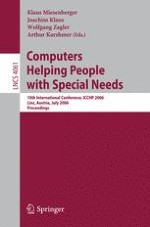2006 | Buch
Computers Helping People with Special Needs
10th International Conference, ICCHP 2006, Linz, Austria, July 11-13, 2006. Proceedings
herausgegeben von: Klaus Miesenberger, Joachim Klaus, Wolfgang L. Zagler, Arthur I. Karshmer
Verlag: Springer Berlin Heidelberg
Buchreihe : Lecture Notes in Computer Science
